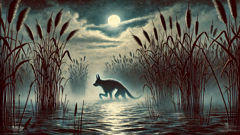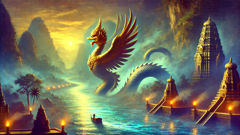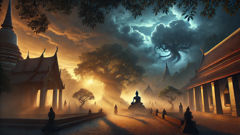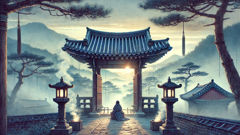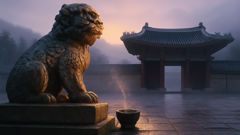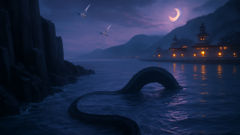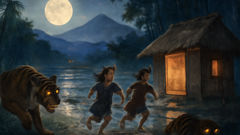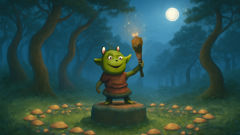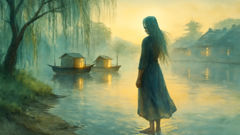Introduction
Along the misty shores of ancient Lake Texcoco, where reeds swayed like whispering guardians and the sun’s last rays shimmered in a thousand golden splinters across the water, fear and awe mingled in the hearts of those who made their home nearby. Here, amid the tangled shallows and winding inlets, legend had woven itself into every stone and ripple: a story of the Ahuizotl, the creature said to dwell beneath the lake’s placid surface, waiting for careless souls to stray too close to its watery realm. The Ahuizotl—dog-like in shape but unlike any known animal—possessed a body slick as obsidian, fur gleaming in moonlight, and eyes that burned with a wild, cunning intelligence. Most terrifying of all was its tail, tipped not with fur or plume but a human-like hand, dexterous and strong, reaching from the depths to snatch the unwary. Fishermen, herbalists, and children had all heard the warnings whispered by their elders: Never linger by the water alone at dusk, for the Ahuizotl is hungry for those who disrespect the lake. Some said it was a vengeful spirit, others believed it was a guardian set by the gods to protect the sacred water from defilement. Its cries—sometimes like a weeping child, other times like a howling pup—echoed across the marshes at night, sending shivers through even the bravest warriors. Yet, among the tales of terror there was also a thread of reverence. The lake and its spirits provided life: fish for the table, reeds for weaving, water for the fields. The Ahuizotl was both a warning and a reminder—tread carefully, respect the unseen, and remember that nature is powerful, mysterious, and alive. This is the story of how one young herbalist, guided by dreams and duty, would come face to face with the legend itself, and in doing so, reveal truths about courage, tradition, and the delicate balance between fear and respect that binds a people to their land.
Whispers by the Water: The Village of Tetzcotzinco
Tetzcotzinco, nestled on the lush, fertile banks east of Lake Texcoco, thrived in the cradle of ancient civilization. The villagers lived in houses of adobe and stone, their gardens bursting with maize, beans, and chilies, their canoes gliding silently through morning mists to gather water lilies and fish. Yet even in the bustle of market days and the laughter of children playing on the riverbank, an undercurrent of tension wound through daily life—one that grew heavier as twilight approached.

The legend of the Ahuizotl was no idle story here. Every home bore its mark: obsidian charms hung from lintels, and woven mats displayed stylized tails and hands to ward off the lurking danger. At night, elders gathered children close and told tales both cautionary and strange: of fishermen vanishing in calm weather, their canoes found spinning in slow circles, nets torn as if by invisible claws; of soft, pitiful cries luring travelers into the marsh, only to be swallowed by silence. The Ahuizotl, they said, punished those who wasted water, who killed more fish than they needed, or who polluted the lake’s sacred heart.
Among the villagers was a young herbalist named Citlali, whose name meant “star” in the Nahuatl tongue. Orphaned as a child and raised by her grandmother Yaretzi, Citlali was known for her skill in gathering rare plants from the lakeshore, her gentle hands healing wounds and fevers with the gifts of earth and water. She listened to the stories with wide eyes but refused to cower. To her, the lake was both a friend and a teacher—a living world of patterns, cycles, and secrets. She respected its power but did not fear its shadows.
One evening, after a festival honoring Tlaloc, god of rain, Citlali wandered alone along the shore, gathering medicinal reeds. The lake was alive with the hum of insects and the distant croak of frogs. Suddenly, a strange sound drifted through the dusk—a cry, plaintive and soft, like a baby calling for its mother. Citlali froze. The warning stories flashed through her mind. Yet instead of fleeing, she knelt, eyes scanning the dark water. The cry came again, closer now, weaving through the reeds. With her heart pounding, she whispered a prayer to Tlaloc and crept forward. There, half-submerged in the shallows, she saw it: slick black fur, a gleaming, elongated body, and a tail ending in a pale, human-like hand that reached out, beckoning.
The Cry in the Reeds: Citlali’s Encounter
Citlali’s breath caught in her throat as she watched the creature. Its fur gleamed like wet obsidian, and its elongated body rippled with hidden strength. The Ahuizotl’s eyes glowed gold and green in the shifting dusk. She felt its gaze pierce her very soul. The creature did not attack; it simply watched, its tail-hand resting atop the water, fingers flexing curiously. The cry that had lured her grew quieter, almost like a song, strange and hypnotic.

She recalled her grandmother’s lessons: If you encounter a spirit, show respect. Do not run or shout. Citlali bowed her head, murmuring gratitude to the lake and its guardian. She offered a bundle of sweet-smelling herbs and floated it on the water. The Ahuizotl’s hand snatched the bundle with unnatural speed. It sniffed the herbs, then fixed her with another intense look before slipping beneath the surface, vanishing as if it had never been there at all.
Citlali returned home trembling, her mind spinning with questions. Had she truly seen the beast? Or had she encountered a guardian spirit testing her heart? She told her grandmother what she’d witnessed. Yaretzi listened with grave attention, then placed a protective amulet around her neck.
Word of Citlali’s encounter spread quickly through Tetzcotzinco. Some called her foolish for approaching; others whispered that she’d been chosen. The village priests summoned her and pressed her for every detail, seeking omens of drought or flood. Fishermen grew wary, refusing to launch their canoes after sunset. For days, the lake seemed quieter, as if holding its breath.
But Citlali could not stay away. The image of the Ahuizotl haunted her dreams, its golden eyes both warning and invitation. She noticed subtle changes: fish moving in different patterns, certain plants blooming out of season. She wondered if the Ahuizotl’s appearance was a sign of imbalance—a message from the gods that something was amiss in the natural order.
Driven by curiosity and a sense of duty, Citlali resolved to learn more. She sought the wisdom of elders and priests, studied ancient codices by firelight, and wandered deeper into the marshes than ever before. The further she ventured, the more she sensed the presence of unseen eyes watching, guiding, and sometimes testing her resolve.
Secrets of the Deep: The Journey Beneath
As the rainy season approached, the mood in Tetzcotzinco shifted. Storms lashed the lake’s surface, turning the shallows to silver and slate. Each night, the Ahuizotl’s cries seemed louder, more insistent, echoing like distant thunder. One evening, after a particularly violent storm, Citlali discovered a trail of torn reeds and scattered feathers by the shore—signs of a struggle. A fisherman had vanished during the night; only his cap and net remained. Panic swept the village.

The priests declared it a curse and prepared offerings to appease Tlaloc. Yet Citlali sensed something deeper at play. She remembered the subtle changes she’d witnessed: the shifting patterns of fish, odd growths among the water plants, and now, a missing man. She wondered if human actions had upset the delicate balance of the lake—if overfishing or careless waste had angered its spirit guardian.
Determined to find answers, Citlali set out alone at dawn, paddling her small canoe into the heart of the lake. The water was eerily still. As mist coiled over the surface, she whispered prayers and scattered marigold petals—flowers sacred to the dead—asking for protection and guidance. Soon, she found herself drawn toward a hidden cove, where the water ran deep and dark. There, shadows danced beneath the surface—shapes too large to be fish.
Suddenly, her canoe jolted. A hand—cold and strong as stone—gripped its edge. The Ahuizotl surfaced, water streaming from its fur. Its eyes locked on hers, and for a heartbeat, Citlali felt herself suspended between worlds. Instead of terror, she felt an overwhelming sense of sorrow—an ancient grief that seeped from the creature’s gaze into her own heart. The Ahuizotl released the canoe, then dove beneath the water, beckoning her to follow.
With trembling hands, Citlali slipped into the lake. The water closed over her head. Light faded, replaced by shimmering patterns of blue and green. She followed the creature through underwater corridors woven with roots and stones, deeper and deeper until she reached an ancient altar carved from basalt. Bones and shells were scattered around it—offerings from ages past.
The Ahuizotl circled the altar, then rested its tail-hand on the stone. Images flickered in Citlali’s mind: villagers polluting the lake, taking more than they needed, ignoring sacred rituals. She saw floods, droughts, and the suffering of plants and animals. The message was clear—the lake’s guardian was not a monster, but a protector, punishing imbalance to preserve the cycle of life.
When she surfaced, gasping for air, Citlali felt changed. She’d been entrusted with a vision—a warning and a plea. If her people did not honor the pact with the lake, more suffering would come. If they remembered gratitude and restraint, balance would return.
Conclusion
Citlali returned to Tetzcotzinco a changed woman. With her grandmother’s blessing, she called a gathering by the lakeshore and shared what she had learned—not just of monsters or curses, but of harmony and respect. She spoke of the pact between people and water, of gratitude for every gift the lake bestowed, and of the consequences when that pact was broken. Some villagers listened with suspicion, others with awe. Over time, Citlali’s words took root. Rituals honoring the spirits grew more frequent. Fishermen returned to their old ways—taking only what they needed, never more. Children learned to clean the shores and leave offerings for unseen guardians. The cries of the Ahuizotl faded into memory, replaced by the gentle lap of water and the songs of frogs at dusk. Yet every so often, when mist curled over Lake Texcoco and shadows danced among the reeds, an echo would rise—a mournful cry, part warning and part blessing. And those who heard it remembered Citlali’s lesson: the world is alive, mysterious, and sacred. To honor its guardians is to honor life itself. Thus the legend of the Ahuizotl endured, not only as a tale of fear, but as a reminder of the delicate balance that binds people to land, water, and spirit for generations to come.

